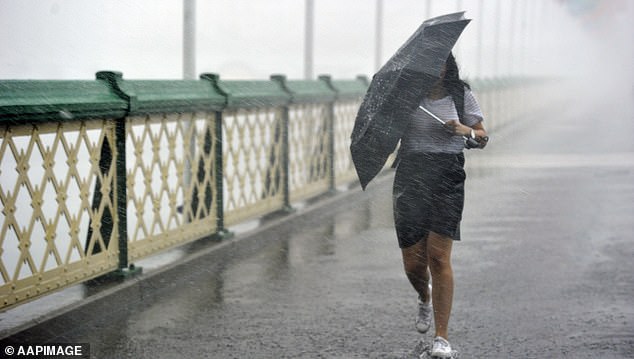Experts have warned New South Wales residents to be prepared for “all weather conditions” as the state is at increased risk of severe storms and higher temperatures ahead of the storm season.
Steve Bernasconi, risk preparedness and response manager at the Bureau of Meteorology, said above-average rainfall and temperatures were expected during the storm season, which typically runs from September to April.
“While the overall flood risk has been assessed as close to average, severe storms can generate significant rainfall in short periods, so flood risks persist in some catchments,” Bernasconi said.
“It is also very likely that we will see above-average maximum and minimum temperatures during the spring.”
Mr Bernasconi said there was a chance of unusually high rainfall in parts of northern NSW in spring, with temperatures forecast to be “winter-like”.
August was the warmest winter on record in New South Wales, while the entire country is having one of the warmest winters on record this year.
“The forecast for spring is for average temperatures to be warmer during the day and warmer at night,” Bernasconi said.
The warmer weather is expected to be driven by warmer sea surface temperatures around the world, with New South Wales under a “La Niña watch”.
There is a high chance that spring rainfall will be “unusually high” with winter temperatures (file photo of a commuter walking in the rain in Sydney)
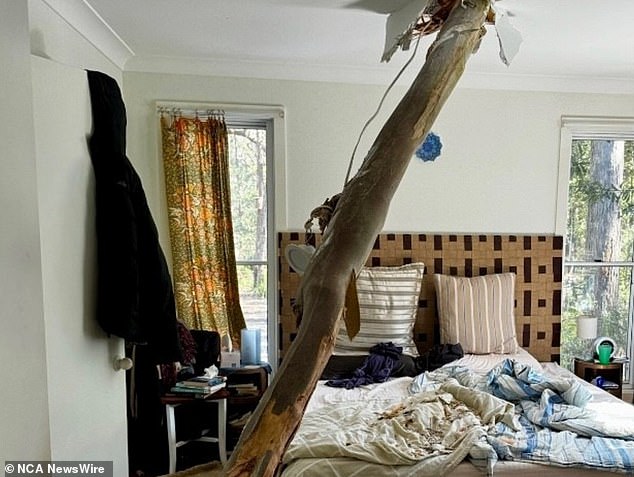
NSW SES crews responded to more than 3,000 incidents in the last week of August and the first week of September. (Photo: NSW SES)
Mr Bernasconi warned that the forecast could mean an increased chance of severe storms.
“Severe storms can bring damaging winds, heavy and intense rainfall, and those rains can lead to flash flooding. In the worst cases, they can also cause giant hail and lightning,” Bernasconi said.
‘And given the conditions, lightning is not one of our friends when it comes to fire either.
“With these prospects… we really need to prepare for all types of weather, for all weather conditions, including fires. Storms can occur at any time of the year and in any season.”
The NSW SES has responded to more than 21,000 storm-related incidents over the past year, with more than 3,000 incidents in the past two weeks alone after the state, along with much of the country, was hit by severe and damaging winds.
Acting NSW SES Commissioner Debbie Platz said storms can occur “all year round” and urged residents to prepare their homes.
‘Have a plan and a home emergency kit, clean your gutters, downspouts and drains, secure loose objects in your backyard and balcony, and trim trees and branches that could fall on your home,’ said Commissioner Platz.
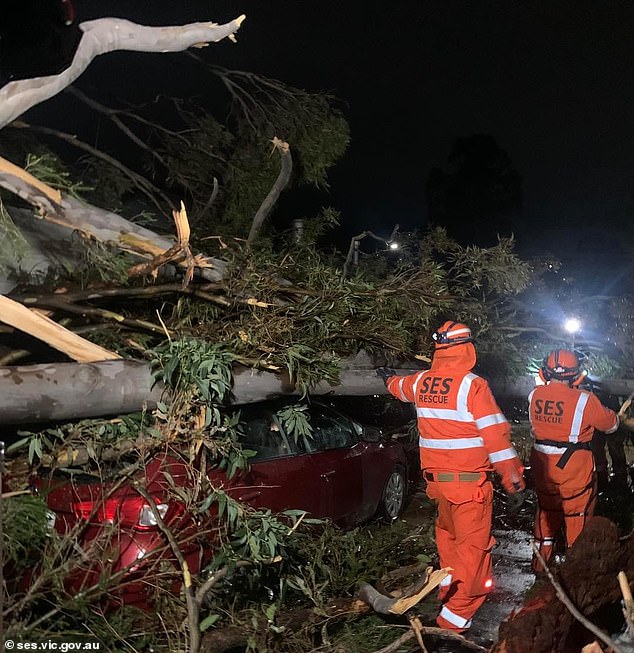
Parts of the country have already suffered damaging winds and destruction. (Pictured, rescue crews work to remove a fallen tree from a car in New South Wales in early September.)
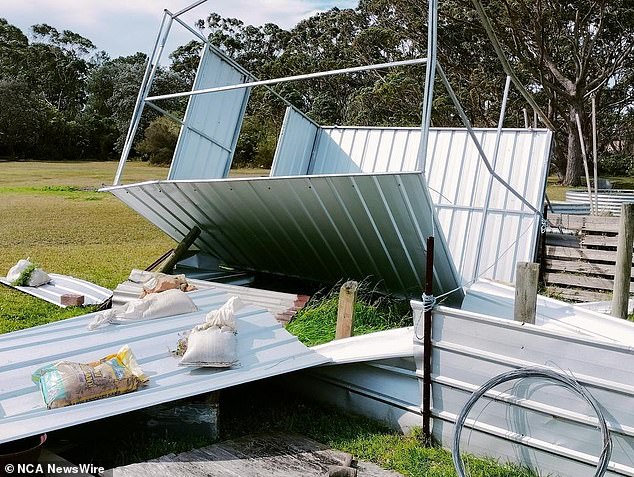
New South Wales suffered property damage due to strong wind gusts and residents are warned to be prepared for all types of weather (pictured, a destroyed shed on a property in New South Wales in early September)
‘Make sure everyone in your home knows what that plan is and what their role is, so that when a storm hits, they can actively participate in ensuring the safety of their family.’
Commissioner Platz also urged people to report any neighbours who are unable to access the internet or apps.
“Some of our neighbors cannot ensure their safety, so I encourage everyone in the community to make sure to check on them and help them in their times of emergency as well,” he said.
“Our SES volunteers are incredibly prepared for this storm season. They train every week to ensure they can keep the NSW community safe.”
Commissioner Platz encouraged people to download the Hazards Near Me app to stay up to date on weather events and launched a call for SES volunteers.
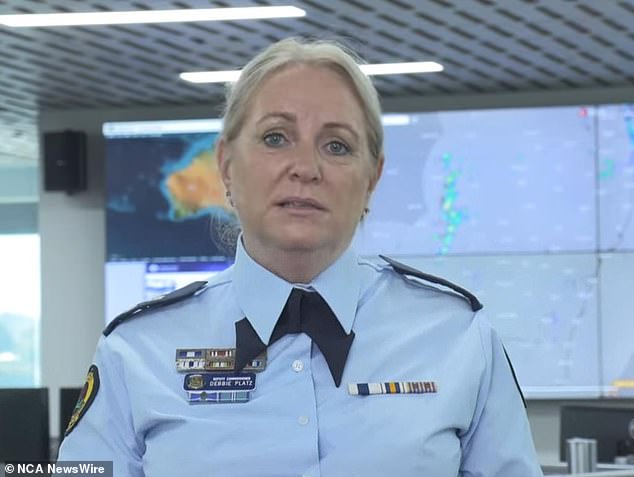
Acting SES Commissioner Debbie Platz urged people to prepare their homes. Photo: SES NSW
Brisbane
Sunday: Sunny. Light winds from the north to the northeast at 15 to 25 km/h at noon and light in the evening.
Monday: Partly cloudy. Possibility of fog in the early morning. Possibility of light rain showers in the afternoon and evening. Light northeast winds at 15 to 20 km/h in the afternoon and east winds in the evening.
Tuesday: Partly cloudy. Chance of morning fog. Medium chance of showers, most likely in the morning and afternoon. Chance of thunderstorms in the west. Light winds becoming east to southeast winds at 15 to 20 km/h during the afternoon then becoming light winds overnight.
Sydney
Sunday: Partly cloudy. Light winds.
Monday: Sunny. Winds from the west to the northwest at 15 to 20 km/h, tending to the west to the southwest in late morning and early afternoon.
Tuesday: Mostly sunny. Light winds.
Melbourne
Sunday: Mostly sunny tomorrow. High chance of showers during the afternoon and evening, increasing to very high chance in the south-eastern suburbs and Dandenongs. Northwesterly winds at 25 to 35 km/h.
Monday: Cloudy. High chance of showers in the Dandenongs, medium chance across the rest of the country. West to northwest winds at 20 to 30 km/h, becoming light in the late afternoon.
Tuesday: Partly cloudy. Light northwest winds at 15 to 20 km/h during the morning and then light during the night.
Adelaide
Sunday: Mostly cloudy. A high chance of showers, most likely this afternoon. Northwest winds at 20 to 30 km/h, shifting to the west at 25 to 35 km/h by midday.
Monday: Cloudy. High chance of showers, most likely in the morning. Westerly winds at 15 to 25 km/h, easing in the afternoon.
Tuesday: Partly cloudy. Chance of morning fog in northern suburbs. Slight chance of rain in hills and southern suburbs, almost zero chance in rest of country. Light winds.
Perth
Sunday: Partly cloudy. Chance of fog in the early morning, mainly in the hills. Light winds.
Monday: Sunny. Light south to southwest winds at 15 to 20 km/h in the early afternoon, then weak in the evening.
Tuesday: Partly cloudy. Winds from the south at 15 to 20 km/h, turning to the southeast at 20 to 30 km/h during the day.
Canberra
Sunday: Mostly sunny. Winds northwest at 15 to 20 km/h, becoming west-northwest at 25 to 35 km/h at noon.
Monday: Partly cloudy. Chance of light rain in the morning. West to northwest winds at 20 to 30 km/h, easing in the afternoon.
Tuesday: Possibility of fog and frost in the morning. Sunny afternoon. Light winds from the north at 15 to 20 km/h in the afternoon and light at night.
Hobart
Sunday: Cloudy. High chance of showers, most likely in the afternoon and evening. Northwest winds at 25 to 40 km/h, turning to the west at 25 to 35 km/h in the evening.
Monday: Partly cloudy. Medium chance of showers, most likely in the early morning and late afternoon. West winds at 25 to 35 km/h, shifting to the northwest at 20 to 25 km/h during the afternoon and evening.
Tuesday: Partly cloudy. Chance of light rain. Northwest winds at 20 to 30 km/h.
Darwin
Sunday: Sunny. Winds from the east to the southeast at 15 to 25 km/h, turning to the north to the northeast at 15 to 20 km/h in the afternoon.
Monday: Sunny. Light easterly winds at 15 to 25 km/h in the morning and light in the afternoon.
Tuesday: Sunny. Light winds from the east to the southeast at 15 to 25 km/h during the morning and from the north to the northeast at 15 to 20 km/h during the afternoon.

